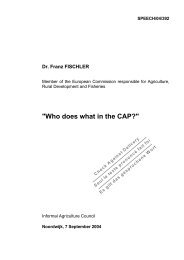B2B Internet Trading Platforms - EDIS
B2B Internet Trading Platforms - EDIS
B2B Internet Trading Platforms - EDIS
Create successful ePaper yourself
Turn your PDF publications into a flip-book with our unique Google optimized e-Paper software.
surplus goods and “seconds” the <strong>Internet</strong> either enabled a market or increased the market’s liquidity<br />
because of its low cost and its wide geographical reach. But also these <strong>B2B</strong> e-marketplaces are<br />
collaborating closely with traditional businesses. Many surplus e-marketplaces, for example, are<br />
working closely together with well-established auction houses. And commodity exchanges are starting<br />
to work together with off-line commodity exchanges, thereby also creating new financial instruments<br />
(e.g. futures contracts) for the goods they are trading.<br />
1.2.3. <strong>B2B</strong> e-marketplaces – a transitory phenomenon<br />
Cost savings are generally accepted as the most significant benefit of participation in e-marketplaces.<br />
However, to fully reap the benefits of cost savings companies must also allow for integration of back<br />
office business processes (logistics, payments, servicing, etc). This, in turn, requires a significant<br />
reorganisation effort and investment, which some companies, particularly SMEs, might not be ready<br />
or capable to undertake. Enterprises, therefore, seem to face a hard choice between low risk but<br />
limited results through “light” participation in e-marketplaces and high risk and costly integration of<br />
their supply chains with business partners.<br />
Business integration calls for relatively stable business relationships in “digital ecosystems”, with<br />
clear and transparent organisational rules and commonly agreed technical standards. A good example<br />
for this type of business integration can be found, for example, in the chemical industry, which is<br />
characterised by a buying-side oligopoly market. Here, many larger companies have set-up, either<br />
individually or together, sophisticated enterprise portals or interconnection hubs. The main objective is<br />
to reduce information-processing costs for buyers and sellers of chemicals within already existing<br />
trading relationships and within well established contracts, e.g. by standardising and automating<br />
information exchange.<br />
Thus, e-marketplaces may be considered as frontrunners for more sophisticated models of supply<br />
chain management. Another new route to be followed in the future could be a model of <strong>Internet</strong><br />
commerce where companies can search for partners directly in peer-to-peer systems, without the<br />
intervention of an intermediary. Technically, e-marketplaces offer little more than expensive software<br />
programmes running on third-party servers. Therefore, the possibility of a complete disintermediation<br />
seems not to be unrealistic, taking into account also the great efforts to standardise electronic<br />
catalogues. In any case, it is important to understand that e-marketplaces might be a transitory<br />
phenomenon, with a potential to be further developed in different directions.<br />
In all these scenarios, trust plays a major role to materialise the full potential of the different solutions<br />
to buy and sell over the <strong>Internet</strong>. Yet, different trust challenges may exist for neutral and independent<br />
e-marketplaces, where transactions are more “spot” oriented as compared with models of integrated<br />
supply chain management where trust is more about cost and risk sharing. Here, companies need to<br />
have reasonable confidence that the required investment needed to make business integration a reality<br />
is going to pay.<br />
As far as trust related issues are concerned, this working document is discussing them mainly for e-<br />
marketplaces, defined as an online service which is offering different trading functions for several<br />
buying and several selling companies. This limitation is motivated by the specific characteristics of<br />
such e-marketplaces which call much more than relatively stable and/or transparent forms of <strong>Internet</strong><br />
trading platforms for clear transparency rules, market transparency and effective dispute resolution.<br />
However, other barriers, such as the lack of awareness, information or standards exist as well and they<br />
apply to all forms of <strong>Internet</strong> trading platforms. In this respect, this paper is not limited to <strong>B2B</strong> e-<br />
marketplaces in the strict sense.<br />
2. BARRIERS TO THE USE OF <strong>B2B</strong> INTERNET TRADING PLATFORMS BY SMES<br />
E-commerce has often been described as the gateway for SMEs to global markets. However, despite<br />
the potential opportunities, many SMEs remain reluctant to engage in electronic transactions. The<br />
eEurope 2002 Benchmarking Report states that “eCommerce faces particular difficulties. It is growing<br />
15





